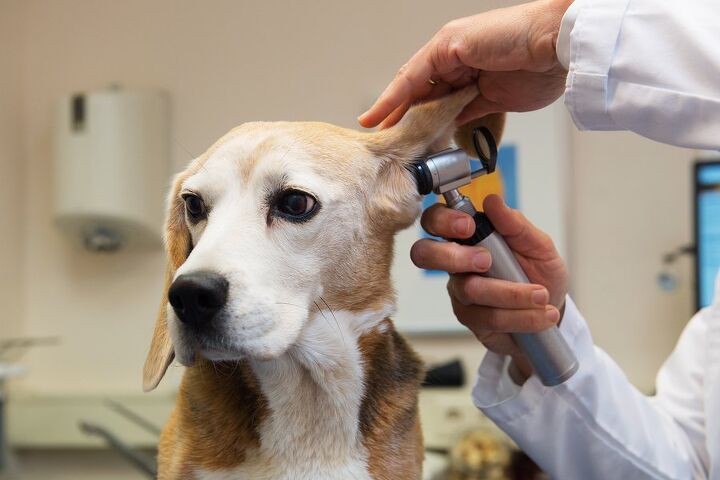Why Do Dogs Get Ear Infections?

If your dog starts pawing at his ears or if you notice a colored discharge draining from his ear canal, he probably has an ear infection. Ear infections are the #1 reason why dogs visit the vet, and they range greatly in severity. Your pet might “just” experience pain and discomfort at first, but if the issue has been neglected for long enough, you risk permanent damage to your pet’s ear canal. Dogs can even go deaf as a result of untreated chronic ear infections! Needless to say, knowing to spot the early signs of ear infections and treating them on time is of utmost importance: it can make all the difference for your poor pooch.
So let’s learn more about what causes this issue in the first place, what are the symptoms of ear infections, and lastly- what can you do to help your pet get rid of this pesky problem. Read on and get all the information you need!
There are two main causes for ear infections in dogs: bacteria and fungus. The most common fungal cause for ear infections is yeast. Yeast is already present in the bodies of most animals but it doesn’t become a problem until the dog’s immune system is weakened by something else – then the yeast can overgrow and start an infection. If your dog suffers from chronic ear infections, there may be an underlying immunological cause that you should have checked out. Bacterial ear infections are caused by pathogenic bacteria that your dog might pick up from an outside source. When these bacteria overgrow, they may cause an infection that can be treated with antibiotic medications.
Related: 6 Ways To Properly Clean Dog Ears
Ear infections make it really apparent how easy it is to disrupt the balance between good and bad bacteria in your pet’s body and the effects it can have on their health. It’s important to make sure that harmful bacteria and yeast don’t thrive in your pet’s body – and that the beneficial microorganisms are present in much higher counts. Even though you might not think it, high-quality dog probiotics are a great way to do that – these supplements will work to improve your pet’s whole immunity, not just their digestive health.
In addition to knowing the underlying causes for ear infections, you should also learn how to identify them. Some of the most common symptoms of ear infections include:
- Unpleasant odor from the ear
- Scratching or rubbing of the head and ears
- Visible discharge coming from the ear
- Swelling or redness in the ear canal or flap
- Shaking or tilting the head to one side
- Pain or tenderness around the ears
- Behavioral changes – depression or irritability
If you notice your dog displaying any of these symptoms, you should take him to the vet for diagnosis. If you catch the infection early, it should be fairly easy to treat and your dog should make a full recovery. In the event of a more stubborn infection, your vet might need to perform additional tests or therapies to discover the underlying cause of the problem.
Related: What Are The Benefits Of Coconut Oil For Dogs?
Preventing ear infections in dogs is actually easy and it can save you a lot of money on vet visits. The most important thing you can do to prevent ear infections in your dog is to keep his ears clean and dry. For some dogs, this takes a little bit more work – especially for dogs with floppy ears or long hair. In fact, that’s exactly why these breeds are more prone to developing ear infections in the first place. Nevertheless, even if it does feel like a chore- it’s important to never neglect the cleanliness of your pet’s ears. The first rule of thumb for preventing ear infections is to clean your dog’s ears when they are dirty. Luckily, that’s not that hard as there are all kinds of dog ear cleaners on the market, from wipes to liquid cleaners. The most common are the latter, as they have proven to be the most efficient type for both prevention and treatment. And don’t be intimidated by the application method: once you know what to do, you can easily get a hang of it. The process is simple: simply squeeze a few drops of dog ear cleaner into your dog’s ear canal then gently massage the base of the ear to spread the cleaner. Next, use a clean cotton ball or swab to wipe away any wax or debris along with the excess cleaning solution. Finally, just let your dog’s ears dry naturally. In addition to cleaning your dog’s ears, it may also help to trim his ear hair short to prevent irritation and to keep moisture from being trapped in the ear.
But, if your dog has already developed an ear infection, he may have to undergo a number of different treatments depending on the severity and the cause of the infection. In order to diagnose what type of infection your dog has, the vet may look at a smear of the ear discharge under a microscope. In many cases, the vet will prescribe a medication to clear up the infection – this should be partnered with regular ear cleaning. If the medication doesn’t work or if the infection comes back, the vet may have to send a sample to a lab for more detailed testing. Apart from the fact that in some cases the treatment can be long-lasting, it’s nothing complicated and pets usually do well on these therapies as they are not invasive and don’t require regular visits to the vet (which most dogs dislike). Most cases require antibiotic treatment, either consumed orally or poured directly in the ear canal, similar to the cleaner. Your vet will prescribe the right type of meds for your pet’s individual situation- in some milder cases, natural remedies can also be used with success. In case your pet’s treated with antibiotics, be sure to include a probiotic supplement that will ensure that the good bacteria still thrives and isn’t eliminated alongside the bad bacteria.
Ear infections in dogs are fairly easy to treat but they are even easier to prevent – just keep your dog’s ears clean and dry and you should be able to cut down on infections. This means taking a little extra care when giving your dog a bath and drying him off after he goes swimming, and making ear cleaning part of your weekly grooming routine. Dog ear cleaners are affordable and easy to use, and by introducing one of these products into your dog’s beauty regimen you’d be doing a lot for their health in the long run. It doesn’t take much to ensure that your pet is at a lower risk for developing infections but you’ll be preventing something that causes much pain and discomfort for your pet.

Kate Barrington is the loving owner of two cats (Bagel and Munchkin) and a noisy herd of guinea pigs. Having grown up with golden retrievers, Kate has a great deal of experience with dogs but labels herself a lover of all pets. Having received a Bachelor's degree in English, Kate has combined her love for pets and her passion for writing to create her own freelance writing business, specializing in the pet niche.
More by Kate Barrington






















